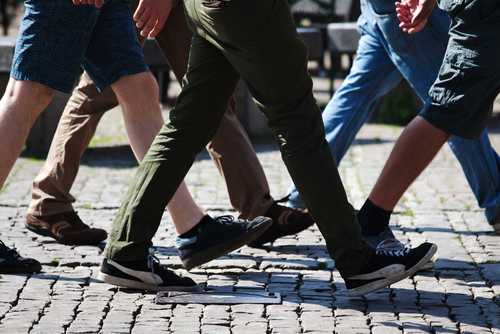Do’s and Don’ts for Preventing Pedestrian Accidents: Drivers Edition
The warmer months mean an influx of walkers, joggers and strollers out and about. Summer vacation also draws children outdoors. Pedestrian accidents account for many unintentional injury-related deaths among children ages 5 to 14, claiming the lives of about 600 children annually. There are many things drivers can do to help prevent pedestrian accidents.

Here are the do’s and don’ts for preventing pedestrian accidents:
- Do: yield to pedestrians at all crosswalks. What exactly defines a crosswalk? Sure, crosswalks can be solid white or yellow lines, maybe even with flashing lines, that are marked on the ground. Not all crosswalk paths are obviously marked. Only a small percentage of crosswalks are explicitly marked. A crosswalk is said to exist at every intersection at which streets meet at right angles
- Don’t: make a turn without watching for pedestrians. Drivers tend to focus on finding a big enough gap in the oncoming traffic. While pedestrians can be hiding in your peripheral vision when you’re trying to make a right turn, it is even more dangerous making a left turn. Drivers typically make left turns more quickly. Turn your head in order to be able to see if there is a pedestrian near. For those who rush to make the left turn, perhaps try to see if there are any pedestrians that will be approaching or is on the crosswalk while you are waiting to find the right time to make the turn.
- Do: Look for eye contact from pedestrians waiting to cross the street. How do you tell the difference between a person simply standing on a street corner and another waiting to cross? Though there’s no foolproof indicator of a pedestrian’s intention, the most reliable answer is eye contact. Pedestrians intending to cross the street very often look for confirmation that the oncoming driver sees them. When a pedestrian is looking to make eye contact with you as you approach, or as you wait to make a turn, it most likely means that he or she intends to cross.
- Don’t: underestimate the effects of bad weather. While many drivers tend to complain of slow drivers, they are only being prepared for applying the brakes at all times. Drivers who go at a slower speed will be able to make the complete stop. Inclement weather usually results in, among other things, poor visibility, and slippery roads. A slippery road means uncertain breaks and maneuverability, a dependable recipe for an accident. Rain and snow are often the most dangerous just after they begin to fall – the oil and dust that has not yet been washed away combines with water to form a slick layer on the road.
- Do: follow special guidelines around blind pedestrians.
-
- Blind pedestrians, no matter if they’re using canes or guide dogs, it is the law to always give the right-of-way.
- Stop your car no more than 5 feet from the crosswalk. Blind pedestrians must rely on the sound of your car in determining whether you have stopped or are continuing to move towards them. Stopping close to the crosswalk can ensure that the blind pedestrian knows you’ve stopped and that it is safe to cross. Those who drive hybrid or electric cars have a more difficult time detecting the presence and motion of the vehicle.
- Do not honk or give verbal directions to blind pedestrians. It will only impair their ability to cross safely.
- Don’t: pass the car in front of you that has stopped at a crosswalk. While you may not see the pedestrian crossing, the car in front of you has probably already given the pedestrian the ability to cross. Drivers tend to assume that the car in front of them is waiting for a left turn but simply forgot to signal, so they zip around the right side and strike the pedestrian as they’re stepping onto the curb. Don’t make any assumptions about the driver in front of you. Whether or not the driver has their turn signal, look for crosswalks and pedestrians then continue the route carefully.
- Do: be especially cautious around schools or where children are likely to be. Children are developmentally unprepared to be consistently safe pedestrians. Their ability to accurately detect the distance, direction, and speed of vehicles by sight and sound requires a degree of cognitive development that many young children don’t yet possess. For example, a child could be chasing after the ball into the street, they’re not exactly thinking about traffic safety, they’re probably thinking about trying to get the ball before losing it. Follow the speed limit posts or go even slower when it comes to schools, developments, or where children are most likely to be.
- Don’t: stop your car in the middle of a crosswalk. Pedestrians are put in serious danger when they are forced to walk around a car blocking their path. Blocking the crosswalk obscures other drivers’ view of the pedestrians, as well as the pedestrians’ view of the oncoming traffic in the opposite lane. It also forces pedestrians to venture outside the crosswalk, whether or not the crosswalk is clearly marked, where other cars my not expect them to be.
- Don’t: block the sidewalk. The pedestrians are forced out of their normal path and to walk either closely behind or in front of the vehicle blocking the way, neither is safe. Remember to also yield to any pedestrian when you’re pulling into or out of a driveway or alley.
- Do: give space for pedestrians in a crosswalk. When you pull up too closely to the crosswalk, it can obscure another driver’s view of the pedestrians.
For more tips on preventing pedestrian accidents, request a free copy of “The Essential Guide to Pedestrian Safety: Know What You’re Walking Into!”